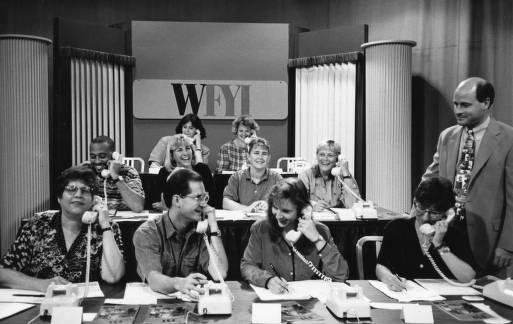With a budget of $221,000, three black-and-white cameras, and nine employees, WFYI signed on the air October 4, 1970, at the under the direction of Warren Wright. It became a charter member of the Public Broadcasting Service two days later. had organized nearly 7,000 women from Indianapolis and vicinity (“Ardath’s Army”) to conduct a subscription campaign to fund the station. The volunteers raised enough money within a few weeks to cover operating expenses for one year.

Owned by Metropolitan Indianapolis Broadcasting, Inc., WFYI first headquartered on North Meridian Street in a building formerly used by Indiana Gas. The station transmitted at low power. Its signal, therefore, did not reach far beyond downtown Indianapolis.
Frank Meek became general manager of WFYI in 1972. Under Meek’s watch, the station increased its power to expand its broadcasting coverage to a 58-mile radius that included most of Central Indiana. During the early 1980s, WFYI also relayed its signal on a translator station to provide educational programming to the residents of Fort Wayne, Indiana. In December 1986, WFWA Channel 39 separated from WFYI to become an independent PBS outlet. That same month, Metropolitan Indianapolis Broadcasting acquired the license of WIAN, the first local National Public Radio affiliate, from the Indianapolis Public Schools. WIAN’s call letters subsequently changed, turning it into sister radio station .

In addition to broadcasting PBS programming, WFYI became the largest producer of television shows for statewide viewing. While Meek was station manager, it launched Indiana Lawmakers (1981-), which offers reporting on the Indiana General Assembly, including interviews with legislators and lobbyists, and Across Indiana (1988-2010), an Emmy-Award-winning, magazine-style program hosted by Michael Atwood, that produced segments revealing typical and atypical Hoosier culture.
In 1989, Lloyd Wright succeeded Meek at WFYI as president and CEO. His early accomplishments in this role included launch of Indiana Week in Review (1991-). Created to provide more complete coverage of Indiana politics, WFYI partnered with to produce the local series. During Wright’s tenure, WFYI’s operating budget grew from $2.5 million in 1988 to more than $11 million. The station successfully completed a $20 million capital campaign and moved to a state-of-the art facility along “Broadcast Row” at 1630 North Meridian Street in downtown Indianapolis in 2008. Reflecting WFYI’s concern for the quality of life in the community, the station organized the “Nitty Gritty City Group” composed of urban grassroots problem-solvers who share ideas, struggles, and successes concerning urban problems.
Before Wright stepped down as WFYI president and CEO, the station had won numerous awards and built a reputation for its collaboration with community partners in the areas of health, education, arts and culture, news and public affairs, as well as Indiana history. The station has received PBS Development Awards, an Emmy Award, and recognition from such organizations as the National Academy of Television Arts and Sciences, Society of Professional Journalists, the Associated Press, and the Indiana Broadcasters Association. Greg Petrowich joined the station as president and CEO in July 2019.
More than 80 professionals work at WFYI Public Media to make it Indiana’s chief PBS and NPR member station and one of Central Indiana’s leading not-for-profits. The WFYI location is one of Indianapolis’ premier media hubs and centers for civic engagement.

WFYI Public Television’s strong broadcast signal continues to cover a 58-mile radius over the most heavily populated urban and rural areas of Indiana. Over 80 cable companies extend WFYI’s educational television programming to residents in West Central and East Central Indiana, bringing WFYI Public Television’s service area to nearly two million households. WFYI is also honored to serve as the flagship PBS and NPR member station for Indiana Public Broadcasting Stations Inc. (IPBS). Approximately 1.6 million households throughout Central Indiana continue to tune in to WFYI Public Television, WFYI 90.1 Public Radio, and visit wfyi.org, and connect with the station on social media.
WFYI Public Media continues to focus on expanding its local production capacity; enhancing its community services to both mainstream and underserved audiences; and building on its proven track record of delivering first-rate local, national and international news coverage.
Digital Television Broadcasting
WFYI Public Television inaugurated its first digital broadcast in 2003. Since that time, digital TV (DTV) technology has enabled viewers across Indiana to have their choice of three separate WFYI channels. WFYI offers three distinct public television services to provide for a variety of needs.
WFYI 1 (20.1) is the station’s main channel offering the traditional PBS fare that Central Indiana families have come to enjoy for more than four decades.
WFYI 2 (20.2) carries WFYI’s PBS KIDS around the clock, 24 hours a day. Voted the #1 educational media outlet in the country, PBS KIDS has research-based, award-winning programs proven to give children a boost in development and improve their chance of success in school. WFYI’s PBS KIDS offers 21 different programs each day. The line-up can be viewed on our schedule page.
WFYI 3 (20.3) offers how-to programming during the day and national and locally produced shows during primetime.

Help improve this entry
Contribute information, offer corrections, suggest images.
You can also recommend new entries related to this topic.

